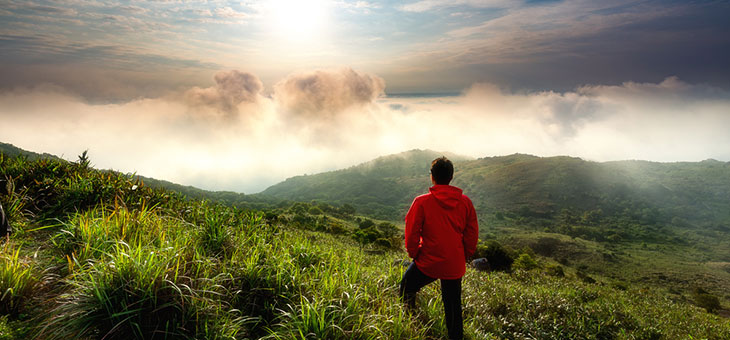I admit it, I’m not a Jimmy Choo shoe kind of gal. Nor am I inclined – shock horror – to spend my entire pay cheque on a Louis Vuitton purse or Hermes scarf. So, what to do in Hong Kong once you’ve eaten your fill of xia long bao and siu mai dumplings? Get outdoors is what. Squeeze near-on 7.5 million people into 1,106 square kilometres and you have the fourth densest conurbation on the planet. But beyond the futuristic skyline and high-rise apartments, Hong Kong has a chunk of nature waiting to be discovered – nearly 70 per cent of the total land mass, in fact, is designated country park or nature reserve. What’s more, you’ll find some of the more remote areas also offer history and culture immersions, so you can have your mooncake and eat it too.
Walking and hiking
Stretching 100 kilometres across New Territories near Sai Kung, The MacLehose Trail is often voted one of the world’s best. It passes sea caves and rock formations and traverses beautiful beaches, forests, rustic villages and Tai Mo Shan (957m), Hong Kong’s highest peak boasting spectacular coastal vistas. Like the MacLehose, Hong Kong’s other major walks – The Wilson (78km), Lantau (70km) and The Hong Kong Trail (50km) – are divided into smaller segments so, more comfortably between November and March, visitors can choose leisurely walks through diverse scenery, be it rugged and coastal, woods and wildflowers, or history and heritage.
Country parks
Many of Hong Kong’s country parks are geared-up for visitors. Shing Mun Country Park, in the south-western New Territories, has an all-level walking trail circling scenic Shing Mun reservoir. Almost 100 years old, the reservoir is known locally as Pineapple Dam, a hangover from the days when Hakka villagers grew fruit crops here. There’s a visitor centre, with information about the park’s old military ruins and proliferation of butterfly species. The trail crosses a charming old dam and winds through young forests where you have a chance to spot some the of park’s resident wild monkeys.
At Plover Cover Country Park, in the north-eastern New Territories, walkers have a different experience, this time weaving their way through bamboo forests that shade the old tiled-roof houses of the Hakka people. One of the best-preserved villages, Lai Chi Wo, has a traditional layout and distinctive decorative Feng Shui wall at its entrance. Tree-spotters should keep an eye out for the century-old maple and camphor trees.
Cultural immersions
Another hike, the Nei Lak Shan Country Trail, stretches across Ngong Ping Plateau on Lantau Island to the peak. But above it, The Ngong Ping 360 scenic cable car offers a completely different view with less effort. The cable cars depart from Tung Chung MTR station and travel 5.7 kilometres across mesmerisingly green tropical vegetation with stunning views of the South China Sea and newly opened Hong Kong to Macao Bridge. Most impressive is the view of Tian Tan Buddha. The massive 34-metre bronze frame seated on a lofty hilltop comes into focus as you near the end of the ride – it’s a splendid vision.
A short walk from the Buddha, Po Lin Monastery is a fittingly serene place to wander around tiled-roof temples and manicured marigoldscented gardens. There’s a basic café where you can dine on simple and affordable vegetarian dishes.
While you’re in this part of Hong Kong, don’t miss remote Tai O, a stilthouse village located a short bus ride away. Situated at the mouth of the Pearl River Delta, this once-thriving fishing village retains its heritage and old fisherfolk ways. Walk through the streets and markets, visit temples and take a boat ride around the stilted homes. Luxury Tai O Heritage Hotel, the restored former marine police station, makes this a tranquil overnight option.
Island hopping
Hong Kong has an incredible 262 outlying islands that offer fun-filled day trips. My favourite (I’m biased because I lived here for a year) is car-free and carefree Lamma Island, a half-hour ferry ride from Central to Yung Shue Wan. Dine on an authentic home-style dim sum breakfast at one of the eateries lining the waterfront, then keep walking past the indie village shops and cutesy cafes along the paved Family Trail. You’ll walk through lush tropical gardens and past little temples and ocean viewpoints. Highlights include Hung Shing Yeh Beach, where you can swim, and the WWII Kamikaze Caves. At the other end, in Sok Kwu Wan village, wrap your chopsticks around a Cantonese seafood feast before catching the ferry back to Central.
Beach bumming
Hong Kong Island has its fair share of beaches but the tranquillity and water clarity tend to improve the further afield you go. Silvermine Bay Beach on Lantau Island is a half-hour ferry from Central to Mui Wo. The pristine water on a big arc of blonde sand here is complemented by the quiet charm of a village surrounded by green hills. With more time, and for a measly few dollars, you can jump in a cab (there’s also a walking trail) to Pui O Beach where palm trees give the sandy shores a tropical feel. There’s a herd of water buffalo and a little temple amid the trees, but you’ll also find a small kiosk that rents surfboards to anyone keen to take on beginner waves.
More
Penny Watson is the author of Hong Kong Precincts, a shopping, eating and drinking guide to the city. Her new carry-on sized Hong Kong Pocket Precincts will be published by Hardie Grant Books in 2019.
See: pennywatson.com.au and hardiegrant.com
Download your free guide to planning your Hong Kong holiday. Or, if you’d like a printed copy packaged and posted to your mailbox, simply fill out this online form and we’ll send it to you!
Related articles:
Hong Kong missed by guidebooks
From street food to fine dining
Welcome to the neighbourhoods

